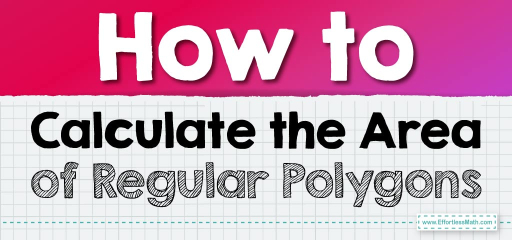How to Calculate the Area of Regular Polygons
Regular polygons, with their equal sides and angles, hold a captivating symmetry that has intrigued mathematicians and geometry enthusiasts for centuries. Whether it's the classic square or the intricate dodecagon, understanding how to determine the area of these figures is essential in both academic and real-world applications. In this guide, we'll embark on a step-by-step journey to unveil the methods to calculate the area of regular polygons, delving into the core principles and formulae that make these calculations a breeze. Join us as we decode the secrets behind these geometrical wonders.

Step-by-step Guide: Area of Regular Polygons
Using Side Length:
- Regular Triangle (Equilateral): Area \(A = \frac{\sqrt{3}}{4} \times \text{side}^2\)
- Regular Quadrilateral (Square): Area \(A = \text{side}^2\)
- Regular Pentagon: Area \(A = \frac{5}{4} \times \frac{\text{side}^2}{\tan(\frac{180}{5})}\)
- Regular Hexagon: Area \(A = \frac{3\sqrt{3}}{2} \times \text{side}^2\)
Using Apothem:
For a regular polygon with \( n \) sides, each of length \( s \), and an apothem of length \( a \):
Area \(A = \frac{n \times s \times a}{2}\)
Examples
Example 1:
Calculate the area of an equilateral triangle with a side length of \(6 \text{ cm}\).
Solution:
\( A = \frac{\sqrt{3}}{4} \times 6^2 \text{ cm}^2 = 15.59 \text{ cm}^2 \)
Example 2:
Find the area of a square with a side of \(5 \text{ cm}\).
Solution:
\( A = 5^2 \text{ cm}^2 = 25 \text{ cm}^2 \)
Example 3:
Determine the area of a regular pentagon with a side length of \(8 \text{ cm}\).
Solution:
\( A = \frac{5}{4} \times \frac{8^2 \text{ cm}^2}{\tan(36^\circ)} = 110.11 \text{ cm}^2 \)
Example 4:
Given a regular hexagon with a side of \(7 \text{ cm}\), compute its area.
Solution:
\( A = \frac{3\sqrt{3}}{2} \times 7^2 \text{ cm}^2 = 127.28 \text{ cm}^2 \)
Example 5:
Calculate the area of a regular pentagon given an apothem length of \(7 \text{ cm}\) and a side length of \(8 \text{ cm}\).
Solution:
\( A = \frac{5 \times 8 \text{ cm} \times 7 \text{ cm}}{2} = 140 \text{ cm}^2 \)
Example 6:
Determine the area of a regular hexagon with an apothem of \(6 \text{ cm}\) and each side measuring \(7 \text{ cm}\).
Solution:
\( A = \frac{6 \times 7 \text{ cm} \times 6 \text{ cm}}{2} = 126 \text{ cm}^2 \)
Practice Questions:
- Find the area of an equilateral triangle with a side length of \(9 \text{ cm}\).
- What is the area of a square with a side of \(10 \text{ cm}\)?
- Determine the area of a regular hexagon with each side measuring \(5 \text{ cm}\).
- For a regular triangle (equilateral) with a side length of \(9 \text{ cm}\) and an apothem of \(7.79 \text{ cm}\), calculate its area.
- What is the area of a square with a side of \(10 \text{ cm}\) and an apothem of \(7.07 \text{ cm}\)?
- Determine the area of a regular pentagon with each side measuring \(11 \text{ cm}\) and an apothem of \(9 \text{ cm}\).

Answers:
- \( 35.07 \text{ cm}^2 \)
- \( 100 \text{ cm}^2 \)
- \( 64.95 \text{ cm}^2 \)
- \( 105.21 \text{ cm}^2 \)
- \( 141.4 \text{ cm}^2 \)
- \( 247.5 \text{ cm}^2 \)
Related to This Article
More math articles
- Order of Decimals, Mixed Numbers and Fractions
- How to Find Infinite Limits and Vertical Asymptotes?
- How to Use a Graph to Factor Polynomials
- How to Remove Ambiguity in Infinite Limits
- The Ultimate SOL Algebra 1 Course (+FREE Worksheets)
- Understanding and Overcoming Math Challenges for Students
- How to Solve Parallel Lines and Transversals Problems? (+FREE Worksheet!)
- 6th Grade SC Ready Math Worksheets: FREE & Printable
- Meet the Key Reasons to Start Learning Math Now
- 4th Grade STAAR Math Practice Test Questions


























What people say about "How to Calculate the Area of Regular Polygons - Effortless Math: We Help Students Learn to LOVE Mathematics"?
No one replied yet.